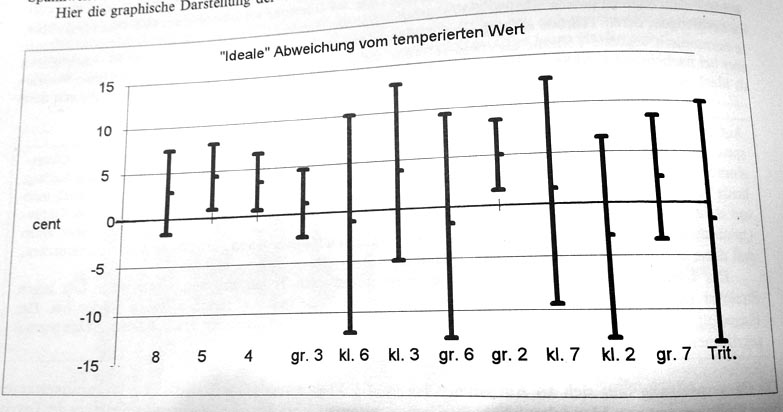In a previous post on flutonation I admitted my tendency to play melodic octaves too wide. Re-reading Doris Geller‘s super book Praktische Intonationslehre I realize this is a universal phenomenon, which she describes as the “inharmonicity of hearing” or perhaps “inharmonicity of the ear”. (original: Inharmonizität des Gehörs).

Here is my paraphrased translation of what she has to say (original German below):
The ear seems to naturally favor tones whose harmonics are spread, as those of a piano are. [Read about this in my previous blog entry here.] This preference is most strongly expressed when we hear successive tones: we find jumps of octaves, fifths, and fourths ideal when they are slightly wider than justly tuned.
And not only these intervals! In a small-scale study she shows the range and average of what students and teachers considered to be an ideal-sounding melodic, linear interval (as opposed to a chordal, vertical interval) relative to equal temperment:
The vertical lines for each interval show the range in which the test subjects found the interval to be ideal. The short horizontal dashes (which may look more like a dots in this picture) through these lines show the average. The 0 line is the interval at equal temperment. The intervals are referred to by number (8= Octave), “kl.” means minor, “gr.” means major.
This really shows how subjective listening can be. 3rds, 6ths, 2nds and 7ths can bear a fairly wide range of variation: they are often context-dependent on their environment. It is no surprise that, out of context, listeners will find their own comfort zone.
I paraphrase from page 84:
The largest diversions at 5.6 cents are quite small, but this can add up. If for example you play these wide fifths or fourths in succession, the third note will produce an octave 8 cents too wide. A whole tone scale with these “ideal” seconds would produce and octave 30 cents too high! However, in solo playing, our pitch memory keeps us from making these mistakes, since temporary overall pitch relationships and the relation to the tonic of the key keep us in line.
Hopefully, when playing an unaccompanied, tonal solo piece, your intonational “snap to grid” function is checked!
Since we get more than the lion’s share of melodic roles, and we have a fantastic body of unaccompanied literature, the expressive and tasteful use of intonation is an important tool for flutists. I am fascinated by the possibilities, and the different practices of vertical (chordal) and linear (melodic) intonation. You will probably be hearing more from me about this as I continue to re-read. It is a pity that Ms. Geller’s book has not been translated into English.
—————————
original German from page 83:
Das Gehör scheint von Natur aus Klänge zu bevorzugen, deren Teiltöne als etwas gespreizt liegen, änlich wie es beim Klavierton der Fall ist. … Noch stärker äußert siche diese Vorliebe aber bei nacheinander erklingenden Tönen. Wir empfinden einen Oktav-, Quint- oder Quartsprung erst dann als ideal, wenn er im Vergleich zur reinen Stimmung etwas zu weit ist.
page 84:
Die Abweichungen sind mit maximal 5,6c zwar gering, doch können sie sich bei Aneinanderreihung in einer Richtung erheblich aufsummieren. Wenn man z.B. Quinte und Quarte in ihrer erweiterten Form in einer Richtung hintereinander spielt, gelangt man beim dritten Ton zu einer um 8c erweiterten Oktave. Und würde man eine Ganztonleiter ausschließlich aus “Idealsekunden” spielen, so wäre die Oktave am Schluß um 30c zu hoch! …In der Einstimmigkeit bewahrt unsunser Tonhöhengedächtnis vor derartigen Intonationsfehlern, denn auch die zeitlich übergreifenden Tonbeziehungen sowie die Beziehungen zum Grundton der gerade herrschenden Tonart werden zur Intonationskontrolle mit herangezogen.

Leave a Reply